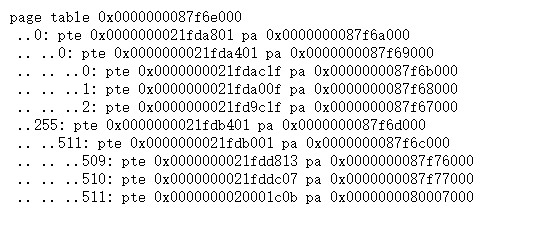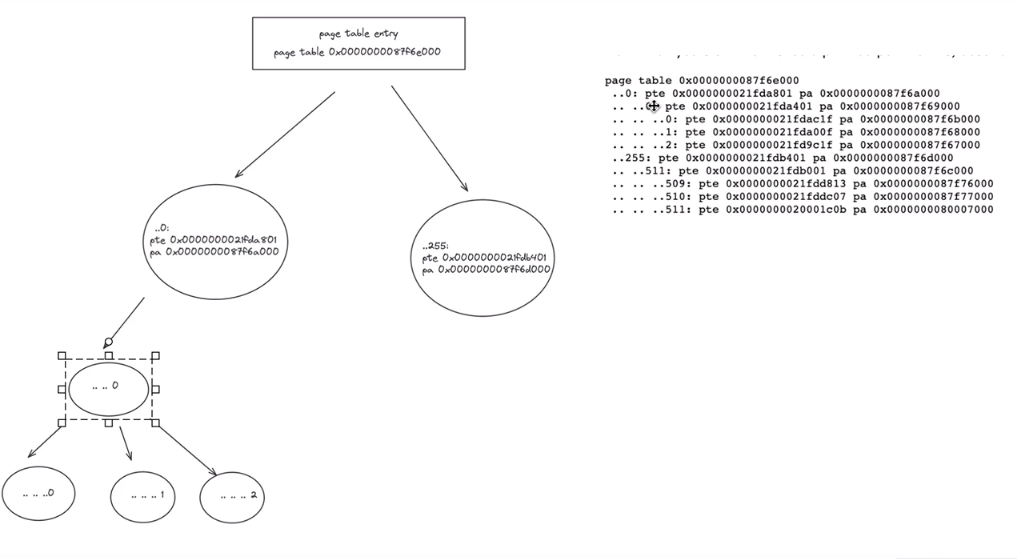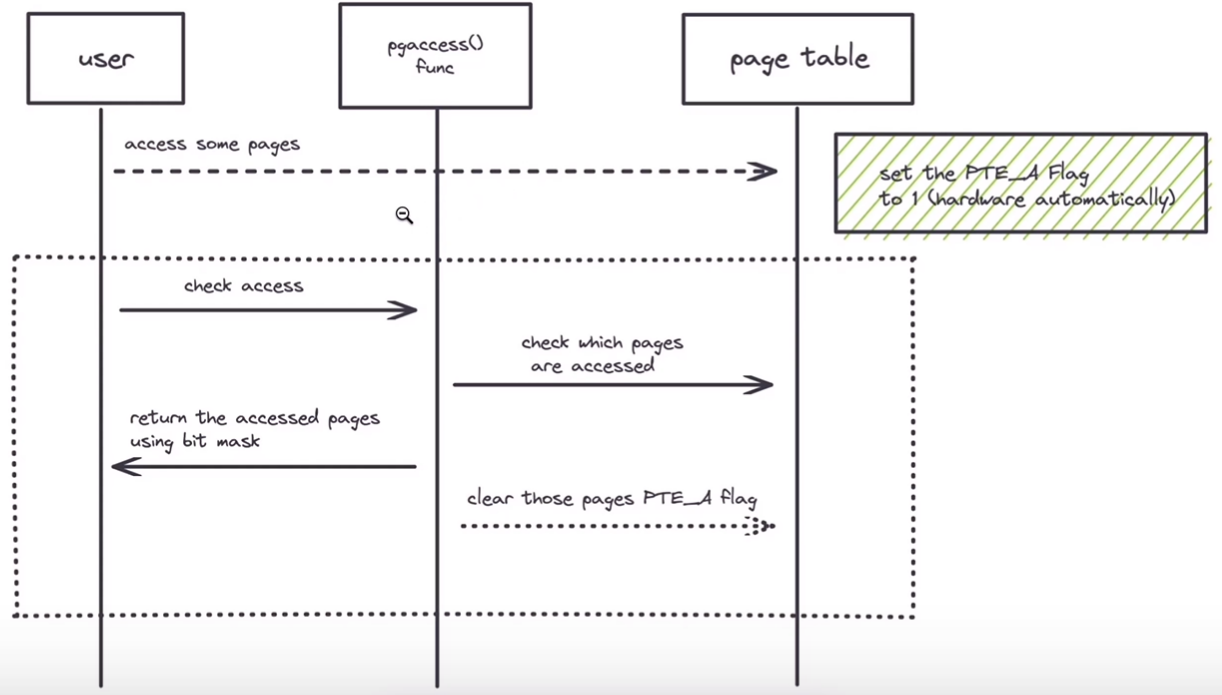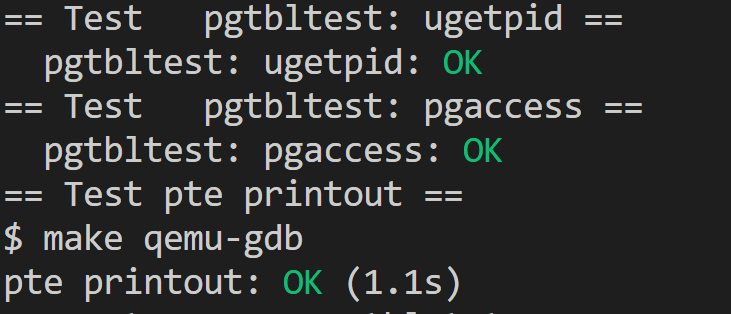6.S081-Lab 3 PAGE TABLES实验笔记
Speed up system calls
一些操作系统 (e.g.,
Linux)通过在只读的区域共享用户空间和内核态空间的数据加速特定的系统调用。这种方法可以减少系统调用需要不断跨越用户态和内核态的需求T.
To help you learn how to insert mappings into a page table, your first
task is to implement this optimization for the getpid()
system call in xv6.
1 | int |
当每个process被创建的时候, 在USYSCALL (a VA defined in
memlayout.h)映射一个只读page . 在页的开头, store a
struct usyscall (also defined in memlayout.h),
and initialize it to store the PID of the current process.
1 |
|
For this lab, ugetpid() has been provided on the
userspace side and will automatically use the USYSCALL mapping.
从上面可以看出应该是TRAPFRAME在TRAMPOLINE下面一页,USYSCALL在TRAPFRAME往下一页的位置
- You can perform the mapping in
proc_pagetable()inkernel/proc.c.
1 | //给进程分配了一个页表 |
我们从上面的函数中可以看到trampoline code和trapframe的映射过程,我们的目标是通过模仿这两个的过程实现对USYSCALL的映射。
Choose permission bits that allow userspace to only read the
page.也就是说我们要将页的权限设为只读的。权限设置部分是在这里操作的:
if(mappages(pagetable, TRAMPOLINE, PGSIZE,(uint64)trampoline, PTE_R | PTE_X) < 0)其中PTE_R
是read,|PTE_X
是可执行,PTE_W是可写。
1 |
- You may find that
mappages()is a useful utility.
mappages(pagetable_t pagetable, uint64 va, uint64 size, uint64 pa, int perm)其中,va是起始地址的虚拟地址对应的物理页的启示地址是pa。其中va和size可能不是页对齐的。如果通过walk函数不能分配所需要的页表就返回-1否则返回0
- Don't forget to allocate and initialize the page in
allocproc()
如下所示我们需要在allocproc这个是分配进程的函数,里面涉及到页的分配,函数里面对模仿Allocate a trapframe page
对usyscall也分配页
1 | allocproc(void) |
- Make sure to free the page in
freeproc().
释放进程的时候同样涉及对页表的释放。
1 | // free a proc structure and the data hanging from it, |
Print a page table
定义一个名叫 vmprint()的函数. 这个函数输入参数是
pagetable_t, and print that pagetable in the format
described below.

Insert if(p->pid==1) vmprint(p->pagetable) in
exec.c just before the return argc, to print the first
process's page table.
Now when you start xv6 it should print output like this, describing
the page table of the first process at the point when it has just
finished exec()ing init。如上图所示。
第一行displays 传给vmprint的参数. After that there is a line for each PTE, including PTEs that refer to page-table pages deeper in the tree. 用" .."` 表示树的深度,第一级两个点,第二级四个,第三级六个.

Each PTE line 显示了the PTE index in its page-table page, the pte bits, and the physical address extracted from the PTE. Don't print PTEs that are not valid.
在上面的例子中,如上图所示,顶级的页表映射了第0项和第255项。下一个层级0映射了0,0项又映射了0,1,2项。
You can put
vmprint()inkernel/vm.c. 首先在vm.c里面定义vmprintThe function
freewalkmay be inspirational.可以参考freewalk函数进行设计
1 | void |
最终函数:
1 | void vmprint(pagetable_t pagetable,uint64 depth){ |
Detecting which pages have been accessed
对于一些垃圾回收机制 (a form of automatic memory management) ,知道那些也是被访问过accessed (read or write)的是十分有用的. add a new feature to xv6 that detects and reports this information to userspace by inspecting the access bits in the RISC-V page table. 当遇到TLB miss的时候 RISC-V 硬件会自动标记 PTE里的这些位.
目标L:实现pgaccess(), a system call that reports which
pages have been accessed.
The system call takes three arguments.:
- First, it takes the starting virtual address of the first user page to check.
- Second, it takes the number of pages to check.
- Finally, it takes a user address to a buffer to store the results into a bitmask (一个数据结构that uses one bit per page and where the first page corresponds to the least significant bit).

Start by implementing
sys_pgaccess()inkernel/sysproc.c. 实现sysproc.c文件里面的sys_pgaccess()函数You'll need to parse arguments using
argaddr()andargint().因为是系统调用,需要上述两个函数获取入参For the output bitmask, it's easier to store a temporary buffer in the kernel and copy it to the user (via
copyout()) after filling it with the right bits. 输出的bitmask需要通过copyout来将其从内核空间拷贝到用户空间walk()inkernel/vm.cis very useful for finding the right PTEs.可以参考walkaddr()和walk函数You'll need to define
PTE_A, the access bit, inkernel/riscv.h. Consult the RISC-V manual to determine its value.

从手册上看,RISC-V处理器会自动置位
1 |
1 | sys_pgaccess(void) |
